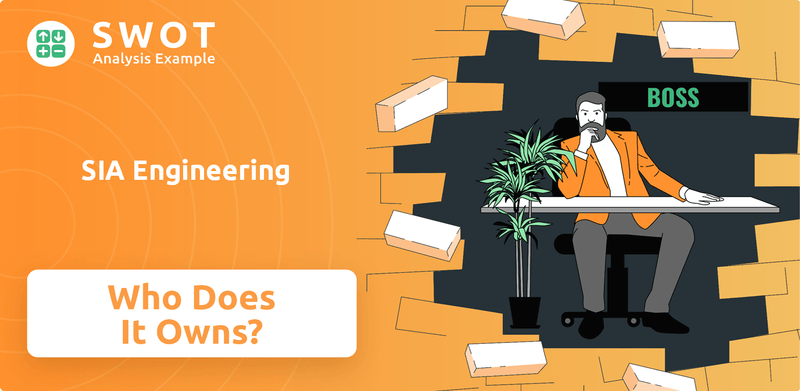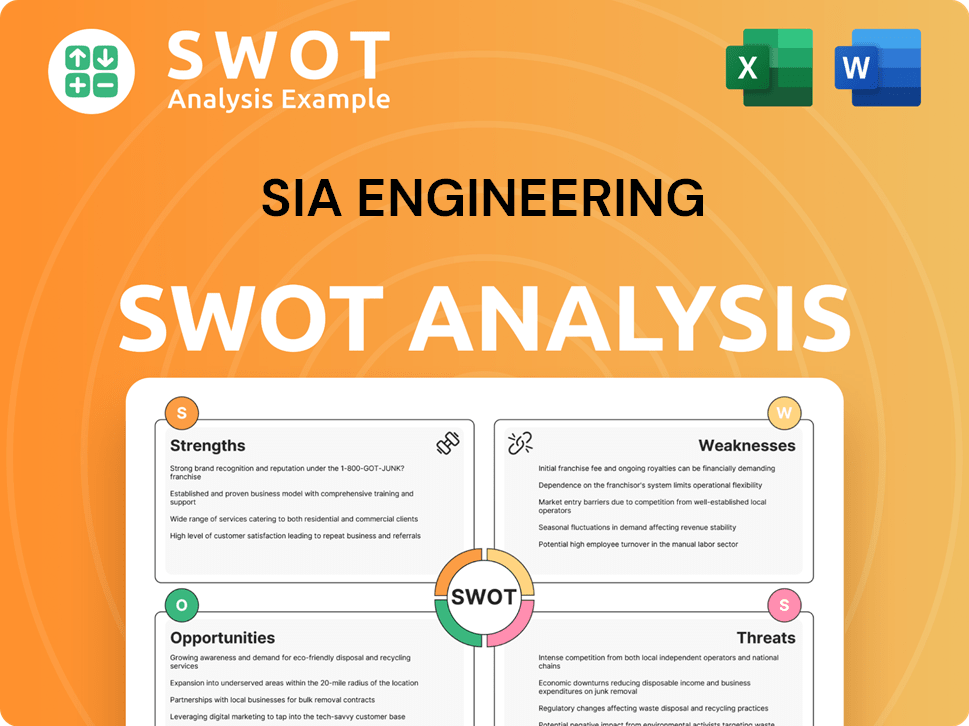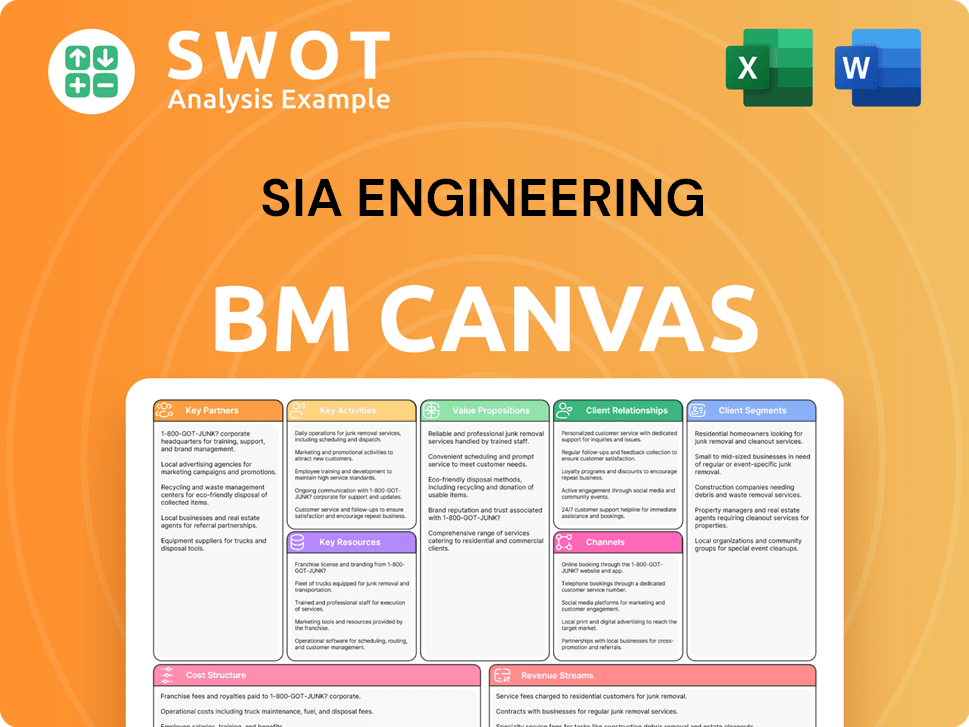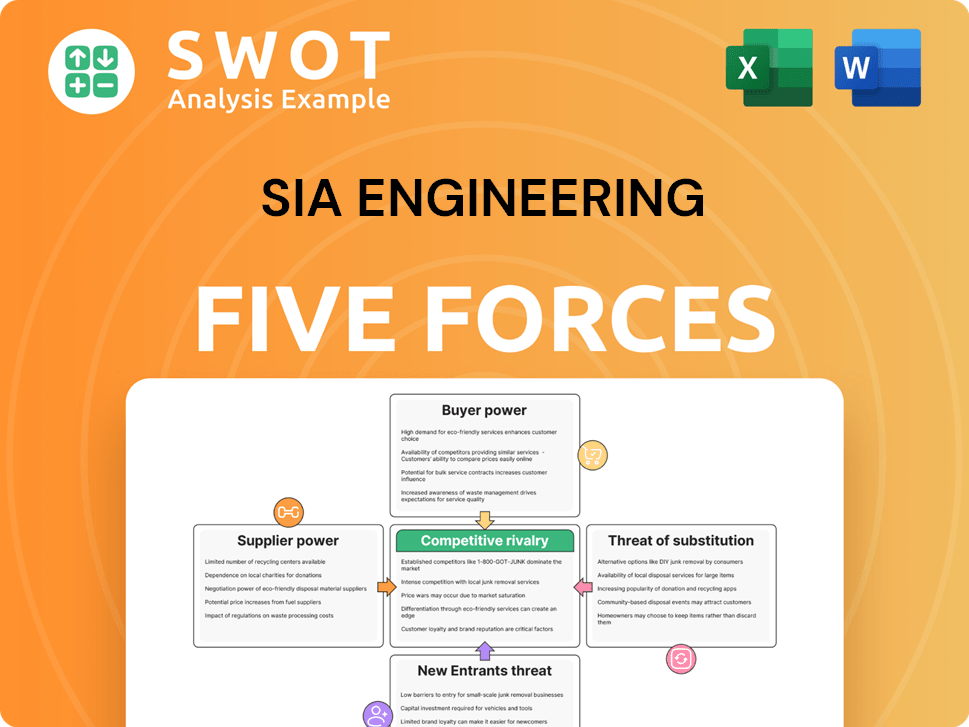SIA Engineering Bundle
Who Really Owns SIA Engineering Company?
Ever wondered who steers the ship at SIA Engineering Company (SIAEC), a global leader in aircraft maintenance, repair, and overhaul (MRO)? Understanding the SIA Engineering SWOT Analysis is crucial. The ownership structure of this key player in the aviation industry dictates its strategic moves, financial health, and overall market performance. Unraveling the details of SIA Engineering Company ownership is essential for anyone seeking to understand its future.

From its roots as a subsidiary of Singapore Airlines to its current standing as a global force, the evolution of SIA Engineering Company's ownership tells a compelling story. This analysis will delve into the shareholding structure, identifying the major players and their influence on the company's direction. Explore the intricate relationship between Singapore Airlines and SIA Engineering Company, and discover how this engineering company ownership impacts its operations and long-term vision. We'll also examine SIA Engineering Company's investor relations and the impact of any recent ownership trends.
Who Founded SIA Engineering?
The initial establishment of SIA Engineering Company (SIAEC) in 1982 marked its inception as a wholly-owned subsidiary of Singapore Airlines (SIA). This foundational structure determined the early ownership dynamics, with Singapore Airlines holding complete control. This arrangement was a strategic move by the parent company to consolidate and enhance its aircraft maintenance, repair, and overhaul (MRO) capabilities.
The creation of SIAEC was not the result of a traditional startup model with individual founders or external investors. Instead, it was an internal initiative by Singapore Airlines to streamline its engineering operations. This setup provided a solid base for the company to grow and eventually offer services to other airlines.
The primary objective behind establishing SIAEC was to build a strong MRO arm. This would support Singapore Airlines' fleet and create an additional revenue stream by offering services to third-party airlines. This strategic decision helped to separate the MRO functions for a more focused approach, setting the stage for potential independent growth in the future.
SIA Engineering Company's initial ownership was entirely held by Singapore Airlines.
The formation aimed to consolidate and expand in-house MRO capabilities.
Operational and financial control was directly integrated within the Singapore Airlines group.
There were no individual founders with equity splits or angel investors.
The vision was to create a robust MRO arm to support its fleet and offer services to third-party airlines.
The structure reflected a strategic decision to separate MRO operations for greater focus and potential independent growth.
Understanding the SIA Engineering Company ownership structure is crucial for investors and stakeholders. The initial ownership by Singapore Airlines shaped the company's early development and strategic direction. For more details, you can refer to this article about SIA Engineering Company: SIA Engineering Company's Ownership and Structure.
- Singapore Airlines initially fully owned SIA Engineering Company.
- The formation was a strategic move to enhance MRO capabilities.
- Early operational and financial control was integrated within the SIA Group.
- The vision included supporting the parent airline and serving third-party clients.
SIA Engineering SWOT Analysis
- Complete SWOT Breakdown
- Fully Customizable
- Editable in Excel & Word
- Professional Formatting
- Investor-Ready Format

How Has SIA Engineering’s Ownership Changed Over Time?
The journey of SIA Engineering Company ownership transformed significantly when it became listed on the Singapore Exchange (SGX). The initial public offering (IPO) on October 12, 2000, marked a pivotal shift, moving the company from a wholly-owned subsidiary to a publicly traded entity. While specific initial market capitalization figures from the IPO are not readily available in recent search results, the listing was a crucial step in its evolution.
The listing on the SGX provided a platform for broader investor participation and increased transparency. This move allowed for the infusion of capital and the potential for future growth through strategic partnerships and acquisitions. The shift also introduced a new dimension of corporate governance, as SIA Engineering Company became subject to the regulations and scrutiny associated with being a publicly listed entity. This change impacted the company's operational and financial strategies.
| Key Event | Date | Impact on Ownership |
|---|---|---|
| Initial Public Offering (IPO) | October 12, 2000 | Transitioned from a wholly-owned subsidiary to a publicly traded company, allowing for broader investor participation. |
| Ongoing Public Trading | 2000 - Present | Fluctuations in shareholding by institutional and individual investors, while Singapore Airlines maintains controlling stake. |
| Regular Financial Reporting | Annually | Enhanced transparency and provided detailed information regarding the company's financial performance and ownership structure to the public. |
As of early 2025, Singapore Airlines remains the primary shareholder of SIA Engineering Company. Recent reports indicate that Singapore Airlines holds approximately 73.1% of the total shares. This significant ownership stake grants Singapore Airlines considerable influence over SIAEC's strategic direction and governance. Other major stakeholders include institutional investors, mutual funds, and individual shareholders who have acquired shares through the public market. The ongoing relationship between Singapore Airlines and SIA Engineering Company is crucial, as highlighted in the Growth Strategy of SIA Engineering.
Singapore Airlines is the controlling shareholder, ensuring strategic alignment and operational efficiency.
- The IPO in 2000 marked a significant shift to public ownership.
- The majority stake held by Singapore Airlines provides a stable base for business.
- Institutional investors and individual shareholders also hold shares.
- Understanding the ownership structure is vital for investors.
SIA Engineering PESTLE Analysis
- Covers All 6 PESTLE Categories
- No Research Needed – Save Hours of Work
- Built by Experts, Trusted by Consultants
- Instant Download, Ready to Use
- 100% Editable, Fully Customizable

Who Sits on SIA Engineering’s Board?
The governance of SIA Engineering Company is significantly shaped by its Board of Directors, which reflects its ownership structure. While a complete list of all board members and their affiliations isn't available without the latest company filings, it is common for the board to include representatives from its majority shareholder, Singapore Airlines, alongside independent directors. The Chairman of the Board typically holds a high-ranking position and often has ties to the Singaporean business community. Key management personnel, such as the Chief Executive Officer, also hold board seats. Independent directors are appointed to ensure diverse perspectives and uphold corporate governance standards. Understanding the composition of the board is key to grasping the dynamics of SIA Engineering Company ownership.
As of early 2025, the exact details of the board's composition can be found in the company's annual reports, usually released in late 2024 or early 2025. These reports provide a comprehensive overview of the board members, their roles, and their affiliations. Investors and stakeholders can access this information through the company's investor relations section or through official regulatory filings. The board's structure is critical to understanding how decisions are made and how the company is managed, directly impacting its performance and strategic direction. For more insights, consider reading about the Marketing Strategy of SIA Engineering.
| Aspect | Details | Impact |
|---|---|---|
| Board Composition | Includes representatives from Singapore Airlines and independent directors. | Ensures alignment with the parent company's strategy and maintains corporate governance standards. |
| Voting Structure | One-share-one-vote. | Provides Singapore Airlines with significant control due to its majority ownership. |
| Governance Stability | Generally stable due to the majority ownership by Singapore Airlines. | Leads to a more predictable governance environment, influencing strategic decisions. |
SIA Engineering Company's ownership is primarily controlled by Singapore Airlines. The board of directors includes members from Singapore Airlines and independent directors. This structure ensures alignment with the parent company's strategy and maintains corporate governance standards.
- Singapore Airlines holds approximately 73.1% of the shares.
- The board's composition reflects this ownership structure.
- One-share-one-vote structure grants Singapore Airlines significant voting power.
- Stability in governance is a key characteristic.
SIA Engineering Business Model Canvas
- Complete 9-Block Business Model Canvas
- Effortlessly Communicate Your Business Strategy
- Investor-Ready BMC Format
- 100% Editable and Customizable
- Clear and Structured Layout

What Recent Changes Have Shaped SIA Engineering’s Ownership Landscape?
Over the past few years, the ownership structure of SIA Engineering Company has remained relatively consistent. The dominant shareholder is Singapore Airlines, which provides a stable base for the engineering company. There have been no significant changes in shareholding or major shifts in the ownership that would fundamentally change the company's structure. This stability is a key feature of the SIA Engineering Company ownership, especially when considering the broader context of the aviation industry.
The focus for SIA Engineering Company has been on growth and expansion within the Maintenance, Repair, and Overhaul (MRO) sector. While there has been ongoing consolidation in the aerospace MRO sector, SIA Engineering Company has primarily pursued strategic partnerships and joint ventures to enhance its service offerings and geographical reach. For instance, the partnership with Safran Aircraft Engines has boosted its engine MRO capabilities. The company’s financial performance, such as the S$68.4 million net profit for the nine months ended December 31, 2023, demonstrates operational stability and recovery following the pandemic, reinforcing its current ownership structure.
| Ownership Aspect | Details | Recent Trends |
|---|---|---|
| Major Shareholder | Singapore Airlines | Consistent majority stake, providing stability. |
| Institutional Investors | Present, but holdings do not challenge Singapore Airlines' position. | Ongoing trading in shares without significant impact on ownership. |
| Strategic Partnerships | Joint ventures and collaborations | Focused on expanding service offerings and geographical reach. |
The relationship between Singapore Airlines and SIA Engineering Company is critical. The strategic alignment provides operational synergies and a stable foundation for the engineering company. For more insights, you can explore the Competitors Landscape of SIA Engineering to understand its position within the industry.
The ownership structure of SIA Engineering Company has been stable in recent years, with Singapore Airlines maintaining a controlling stake. This stability provides a solid foundation for the company's operations and strategic initiatives. There have been no major changes in shareholding that would significantly alter the company's fundamental ownership structure.
While the broader aerospace MRO sector has seen consolidation, SIA Engineering Company has focused on strategic partnerships to enhance its capabilities. These collaborations aim to expand service offerings and geographical reach. The company's financial performance, such as its recent profits, reflects its operational stability and post-pandemic recovery.
SIA Engineering Porter's Five Forces Analysis
- Covers All 5 Competitive Forces in Detail
- Structured for Consultants, Students, and Founders
- 100% Editable in Microsoft Word & Excel
- Instant Digital Download – Use Immediately
- Compatible with Mac & PC – Fully Unlocked

Related Blogs
- What are Mission Vision & Core Values of SIA Engineering Company?
- What is Competitive Landscape of SIA Engineering Company?
- What is Growth Strategy and Future Prospects of SIA Engineering Company?
- How Does SIA Engineering Company Work?
- What is Sales and Marketing Strategy of SIA Engineering Company?
- What is Brief History of SIA Engineering Company?
- What is Customer Demographics and Target Market of SIA Engineering Company?
Disclaimer
All information, articles, and product details provided on this website are for general informational and educational purposes only. We do not claim any ownership over, nor do we intend to infringe upon, any trademarks, copyrights, logos, brand names, or other intellectual property mentioned or depicted on this site. Such intellectual property remains the property of its respective owners, and any references here are made solely for identification or informational purposes, without implying any affiliation, endorsement, or partnership.
We make no representations or warranties, express or implied, regarding the accuracy, completeness, or suitability of any content or products presented. Nothing on this website should be construed as legal, tax, investment, financial, medical, or other professional advice. In addition, no part of this site—including articles or product references—constitutes a solicitation, recommendation, endorsement, advertisement, or offer to buy or sell any securities, franchises, or other financial instruments, particularly in jurisdictions where such activity would be unlawful.
All content is of a general nature and may not address the specific circumstances of any individual or entity. It is not a substitute for professional advice or services. Any actions you take based on the information provided here are strictly at your own risk. You accept full responsibility for any decisions or outcomes arising from your use of this website and agree to release us from any liability in connection with your use of, or reliance upon, the content or products found herein.